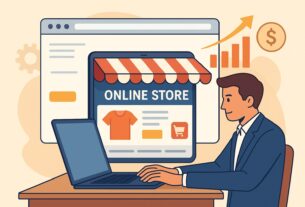The way people buy and sell has changed permanently. Ecommerce, once a niche segment, now stands as a major part of everyday life. Whether shopping for clothes, gadgets, or groceries, online platforms have become essential. For businesses, understanding how ecommerce operates and what makes it successful is no longer optional—it is necessary for long-term survival.
Online stores are no longer limited to large brands. Small businesses, individual creators, and service providers now run shops that serve both local and global audiences. This article breaks down the major aspects contributing to the continuous growth of ecommerce, focusing on both consumer behaviour and business strategy.
Rising Demand for Personalised Shopping
Online shopping is not just about convenience anymore. Customers expect a personal experience when visiting a website. From product recommendations to customised offers, ecommerce websites need to meet growing expectations.
For example, websites now display suggestions based on previous purchases or browsing history. This helps shoppers find products more quickly, creating a sense of satisfaction while also boosting sales for the business.
Additionally, many online stores now allow customers to create wish lists, track orders easily, and receive updates via email or app notifications. These small features keep users engaged and help businesses build stronger relationships with their customers.
To build a strong presence and stand apart from competitors, check out this helpful guide:Building an Ecommerce Store That Stands Out.
The Shift Towards Mobile Shopping
More than half of all ecommerce traffic now comes from smartphones and tablets. Customers are browsing and purchasing while on the move—during commutes, lunch breaks, or evenings at home. Businesses must make sure their websites are mobile-friendly, loading quickly and displaying products clearly on smaller screens.
Mobile payment methods such as UPI, Google Pay, and Apple Pay have also contributed to this shift. They reduce friction at checkout, allowing purchases to happen in seconds.
Ecommerce apps have grown popular too, especially among frequent buyers. They offer faster access to products and provide exclusive deals or loyalty programs.
Social Media’s Role in Ecommerce
Social media platforms have become more than just places to share photos or updates—they are now active sales channels. Brands use platforms like Instagram, Facebook, and TikTok to showcase products and connect with potential customers.
Live selling events, influencer partnerships, and social commerce features (like shoppable posts) allow businesses to reach audiences where they already spend time. This reduces the need for traditional advertising and creates more organic customer engagement.
While these trends are familiar in the fashion and beauty industries, they have also impacted other sectors such as electronics, home goods, and even food delivery.
The broader picture of how ecommerce is affecting various industries is well illustrated here:Ecommerce Development Is Reshaping
Data-Driven Decisions in Ecommerce
Behind every successful ecommerce business is a system for collecting and analysing data. From tracking website visits to monitoring purchase patterns, businesses today rely on insights to make informed decisions.
For instance, knowing which products sell best during specific seasons allows businesses to adjust their stock levels in advance. Similarly, analysing customer feedback helps in improving product quality or customer service.
Tools like Google Analytics, Shopify Analytics, and customer review platforms make it easier for even small business owners to track performance. These insights lead to smarter marketing campaigns, optimised inventory management, and more efficient customer support systems.
The Importance of Trust and Security
With increasing online transactions, shoppers have grown cautious about privacy and payment security. Displaying clear privacy policies, SSL certificates, and secure payment options has become essential.
Customers want to know that their personal and financial information is safe. A single security breach can damage a business’s reputation and result in loss of trust that is hard to regain.
Businesses must also ensure transparent policies regarding returns, refunds, and shipping to maintain confidence among buyers. This is particularly important when dealing with international customers or high-value purchases.
Customer Journey and Experience
From the first click on a product image to the final step of payment, the customer’s experience needs to be smooth and frustration-free. Complicated menus, unclear product descriptions, or slow website performance can quickly drive potential buyers away.
Simplifying navigation, writing clear product details, adding multiple product images, and offering easy-to-use filters are all key points to consider.
One example of how thoughtful customer journey design can lead to greater business success is shared in this blog:From Clicks to Confidence
Sustainability and Ethical Shopping Trends
More customers are choosing to support brands that care about sustainability and ethical practices. Ecommerce businesses now highlight eco-friendly packaging, fair trade products, or donations to social causes as part of their brand story.
For businesses, this is not just a marketing tactic but an actual shift in operating values. Customers are willing to pay slightly more if they feel confident that a product aligns with their personal ethics.
Many ecommerce platforms also offer features like carbon-neutral shipping options or recycled packaging, which appeal to environmentally conscious shoppers.
The Role of Artificial Intelligence
While artificial intelligence may sound complex, its applications in ecommerce are increasingly common. Chatbots, for instance, provide real-time customer support. AI-based recommendation engines suggest products shoppers are more likely to buy.
AI also helps businesses predict inventory needs, reduce return rates, and optimise advertising spend. It’s becoming part of everyday ecommerce operations rather than a futuristic concept.
Conclusion
Ecommerce is not just an online version of retail—it is its own dynamic ecosystem. From mobile shopping habits to ethical consumer choices, businesses must stay aware of changing trends and customer expectations.
To succeed, businesses need a reliable online store, smart marketing strategies, trustworthy payment systems, and consistent customer service. These elements work together to create long-term growth and customer loyalty.
Whether starting a small online shop or expanding an existing business, understanding ecommerce fundamentals is key to achieving meaningful results in today’s digital marketplace.
Author: Pratik Patel
WEDOWEBAPPS
is
a
leading
USA-based
software
development
company
delivering
end-to-end
digital
solutions
for
enterprises
and
startups.



